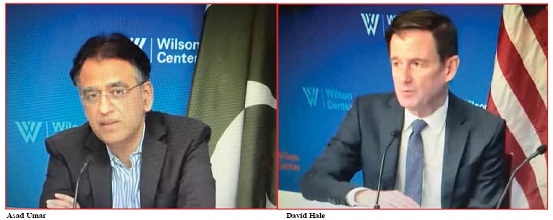Asad Umar Demystifies CPEC at Washington’s Wilson Center
By Elaine Pasquini

Washington, DC: The China-Pakistan Economic Corridor (CPEC) is the $60 billion Pakistan component of Chinese President Xi Jinping’s global infrastructure plan known as the Belt and Road Initiative.
On October 22, David Hale, distinguished diplomatic fellow at the Wilson Center, formerly ambassador to Pakistan, Lebanon and Jordan, engaged in an illuminating discussion with Asad Umar, Pakistan’s federal minister for planning, development, reform and special initiatives, on the status and future of this ambitious enterprise.

Summarizing Pakistan’s economic environment, Umar began with discussing the country’s exports. The largest export destination for Pakistan is the EU, he said, but the largest single country export destination is the US. “The Chinese export is the third largest, but has not really grown significantly…and is not the one which has been driving Pakistan’s economy recently,” he explained. “But if you look at direct foreign investment inflows you will see a very sharp increase of Chinese investment coming into the country and this is the impact of CPEC showing up.”
CPEC’s single largest investments are in power generation, Umar continued. “Pakistan had a significant power generation deficit…that…has now largely been addressed by capacities set up under CPEC.” A new power generation capacity of 5,300 megawatts – about one-fourth of the total power generation capacity of the country – has been created, and projects under implementation or in the planning stage will add significantly to that volume.
Other projects brought in under the CPEC umbrella include upgrading the transmission systems, installation of additional transmission lines, 1,800 km of new motorways and highways, mass transit projects and the first major railways upgrade. In addition, an international airport at Gwadar is under construction.
Regional connectivity is a major focus of CPEC’s projects. But, Pakistan, Umar pointed out, “is a prisoner of its geography.” In the north are Pakistan’s large, spectacular mountain ranges. To the east is India whose government currently is not interested in opening up to Pakistan. Iran, on Pakistan’s western border, remains under US sanctions, so it is also blocked to Pakistan for regional trade and connectivity.
All of this leaves Afghanistan, and through it Tajikistan, Uzbekistan and Turkmenistan, as “the corridor of opportunity for us that we can look at…and this is where CPEC comes in” to build road or rail networks, Umar explained. “We have been boxed in and that is obviously limiting our economic development potential.” If the situation stabilizes, we can “go and connect to the rest of the world.”
What has led Pakistan repeatedly into International Monetary Fund programs is its “inability to sustain external debt obligations,” Umar related. The largest non-debt foreign currency inflows which are vital for Pakistan’s economic viability and growth come from the EU as a block, “but as a single country it is the US which is providing 14 percent of all the non-debt foreign currency inflows coming into the country.”
A major source of foreign exchange influence in Pakistan is the remittances from Pakistanis living abroad which are sent back into the country, he said, with the largest contributions coming from Saudi Arabia, followed by the UAE.
Responding to criticism of Pakistan’s debt vis-á-vis China, Umar noted that Pakistan has had a debt problem for a long time. “For the last 30 years we have almost continually been going back into IMF programs and that’s obviously way before CPEC ever was heard of,” he said.
Umar was upbeat about Pakistan’s ability to quit relying on assistance from the IMF. The first three months of this year export growth has increased by nearly 30 percent, he said. IT exports increased by 47 percent last year and remittances have grown. “Once we are able to get successful sustained growth in these flows, that’s when you come off permanently from an IMF program.”
In CPEC’s second phase, four Special Economic Zones (SEZs) are being developed, which are not “China-specific,” Umar explained. “Any country in the world can invest in these SEZs.”
Industry and agriculture are also top priorities in the second phase of CPEC. These are labor-intensive and the overwhelming manpower will be Pakistani manpower, he emphasized.
To facilitate investment for international companies, incentives have been improved and an investment facilitation center is being set up…which allows a “plug-and-play environment so companies can come, set up shop, minimize their up-front investment and start moving quickly,” Umar enthused.
Post 9/11, Pakistan suffered a serious security environment which deterred investors from the West. “Things have become significantly better since then,” he stated. “The Pakistani security forces have carried out a phenomenal job. We hope countries from all over the world…will come and participate.”
Pakistan, being heavily affected by climate change, is now focusing on environmentally-friendly renewal projects, Umar said. “[Climate change] is something…that we face the consequences of in our daily lives.” One highlight is Pakistan’s internationally acknowledged tree planting program, the goal of which is to plant 10 billion trees in the next five years.
Regarding the global problem of rising inflation, Umar said that Pakistan’s immediate emphasis is to protect the most vulnerable. “But the people of Pakistan are feeling the pressure of inflation.”
CPEC, Umar stressed, “is an initiative which is good for Pakistan; it’s good for China, and we believe, if done right and particularly if Afghanistan stabilizes, it will be good for the region.”
In conclusion, Umar emphasized that “Pakistan needs to do a better job of reaching out” because not everyone around the world has heard that “the situation in Pakistan has improved in the past years…and it is definitely a much safer place.”
“There are 225 million consumers in Pakistan,” he pointed out. “The people are welcoming and there are great economic opportunities. As Pepsi, Coca Cola and Procter and Gamble can tell you, it’s a market worth being in. We need to get the word out.”
(Elaine Pasquini is a freelance journalist. Her reports appear in the Washington Report on Middle East Affairs and Nuze.Ink.)
-----------------------------------------------------------------------------
Back to Pakistanlink Homepage

